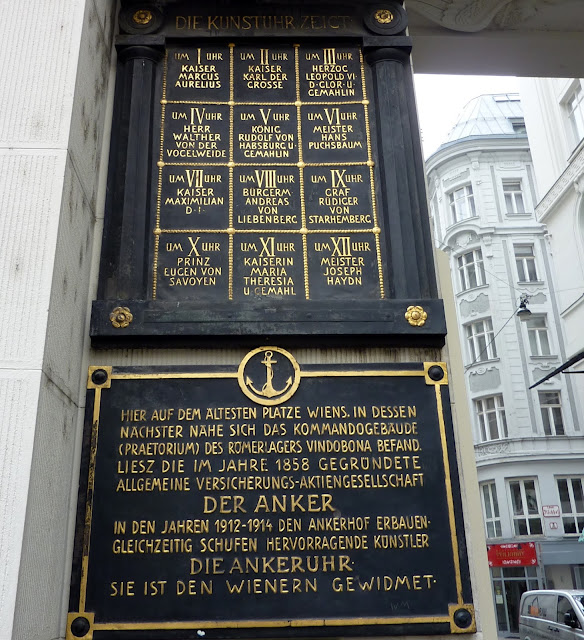Our walk started with Ruprechtsplatz as we wanted to have a look at the Ruprechtskirche (post to follow).
We then walked on to the Hoher Markt (High Market), on the edge of what was once the city's textile district. The square's name denotes its former importance as a commercial hub. It's the oldest public square in Vienna, but you wouldn't know this from looking at it - all the buildings around the square were destroyed during WWII, either by Allied bombing raids or by the artillery bombardment that preceded the arrival of Soviet forces in 1945.
In the centre of the square stands the Vermahlungsbrunnen (Wedding Fountain), baroque in style, built in 1729.

The Ankeruhr (Anker Clock) is the second feature of this square. An Art Nouveau masterpiece, created by Franz von Matsch in 1911, and named after the Anker Insurance Co, which commissioned it. People flock here at noon, when figures trundle past in succession to the tune of organ music.
Over a 12-hour period, figures slowly pass across the clock face, indicating the time against a static measure showing the minutes. Figures range from Marcus Aurelius to Josef Haydn.
Details of who's who are on this plaque on the wall below.
We continued up Lichtensteg admiring its grand buildings.
We then went to see the exhibition of 'The Documentation Centre of Austrian Resistance' (post to follow). 'Flower Power', by Maria Wiala stood proudly in the courtyard.
This chimney sweep on the side of this building made us chuckle
looking closer.
From the 13th to the 15th centuries this area was home to a thriving Jewish community. In 1421 emperor Albert V chose Vienna's Jewish population as a scapegoat to distract people from his disastrous military defeats. He whipped up public outrage about a series of imaginary heresies and Jewish crimes before calling for the expulsion of Austria's entire Jewish population. The hundreds that didn't manage to escape were burned at the stake on the outskirts of town. Vienna became known in medieval Jewish culture as the 'city of blood'. When Jews were allowed to return 250 years later, they did not settle in this area but Judenplatz remained an important focal point for the community.
In the early 20th century the increasingly hostile local government began driving many people away. In the face of institutional anti-Semitism and frequent mob violence many thousands fled the city, a movement that accelerated further after the Anschluss - Vienna's 1938 union with Nazi Germany when Austrian far-right groups had seized control of almost every public institution. Thousands of Austrian Jews were arrested; some were immediately sent to concentration camps, while others were severely beaten before being released and instructed to leave the country immediately. The situation was at its worst in Vienna where the racist policies of the Nazi government served to stoke the fires of the city's already violent anti-Semitism.
The nights of November 9 and 10, 1938 - better known as Kristallnacht - were largely uneventful in Austria, but in Vienna an armed mob descended on Leopoldstradt and the Jewish suburbs. Homes were ransacked, businesses trashed, and men, women and children were attacked or killed. By the end of this orgy of violence, almost every of Vienna's 100 synagogues had been burned to the ground. The only synagogue to survive was the one on Steinstettengasse which was not burned down because it could risk the Nazi party headquarters which was only 100 yards away.
After the war those Jews who survived decided not to return to a place where they did not feel welcome. Most of the Jews living in Vienna today came from Eastern Europe.

We reached Judenplatz (Jewish Square)
which is dominated by the Holocaust Memorial, by Rachael Whiteread.
Its proper name is 'Memorial to the Austrian Jewish Victims of the Shoah'. It commemorates the 65,000 Viennese Jews who were murdered during the Nazi regime. It was created on the initiative of Simon Wiesenthal. The reinforced concrete cube represents an introverted, non-accessible library. Countless editions of the apparently same book stand for the large number of victims and their life stories.
The Jewish Museum is in this square too. This is part of the information we were given: 'Simon Wiesenthal played a leading role in facing up to the Nazi past and wrote an important chapter in aspects of Austria's post-war history that some would have preferred to forget'.
This is certainly what we observed: Austria's role and responsibility in the persecution of the Jews and the Holocaust seems to be ignored, as if it had not happened. The contrast with Berlin, where the country's past is constantly recalled and regretted, where atonement seems to be part of everyday life, is stark.
The leaflet continues: 'For Wiesenthal, a Holocaust survivor born in Galicia, Vienna became the hub of his untiring search for justice. In the 1990s he finally succeeded in his long standing demand for a memorial on Judenplatz to the Austrian Jews murdered during the Shoah, adding an important monument to his adopted city'.
Am Hof square was the next place we walked to, with its selection of 16th and 17th century buildings. In the middle of the square is the baroque Column of our Lady, which was erected in 1667 to honour the Catholic victory over the Swedish Protestants in the Thirty Years' War.
The Palais Colalto is where 6-year old Mozart gave his first public performance.

The Verbund headquarters stands in a corner of the square, where Danish-Icelandic artist Olafur Eliasson has made an intervention. Every day at dusk, the façade of the building is shrouded in yellow fog, thus changing the perception of the entire plaza ensemble. It's called Yellow Fog. Unfortunately we were not able to visit at night.














No comments:
Post a Comment